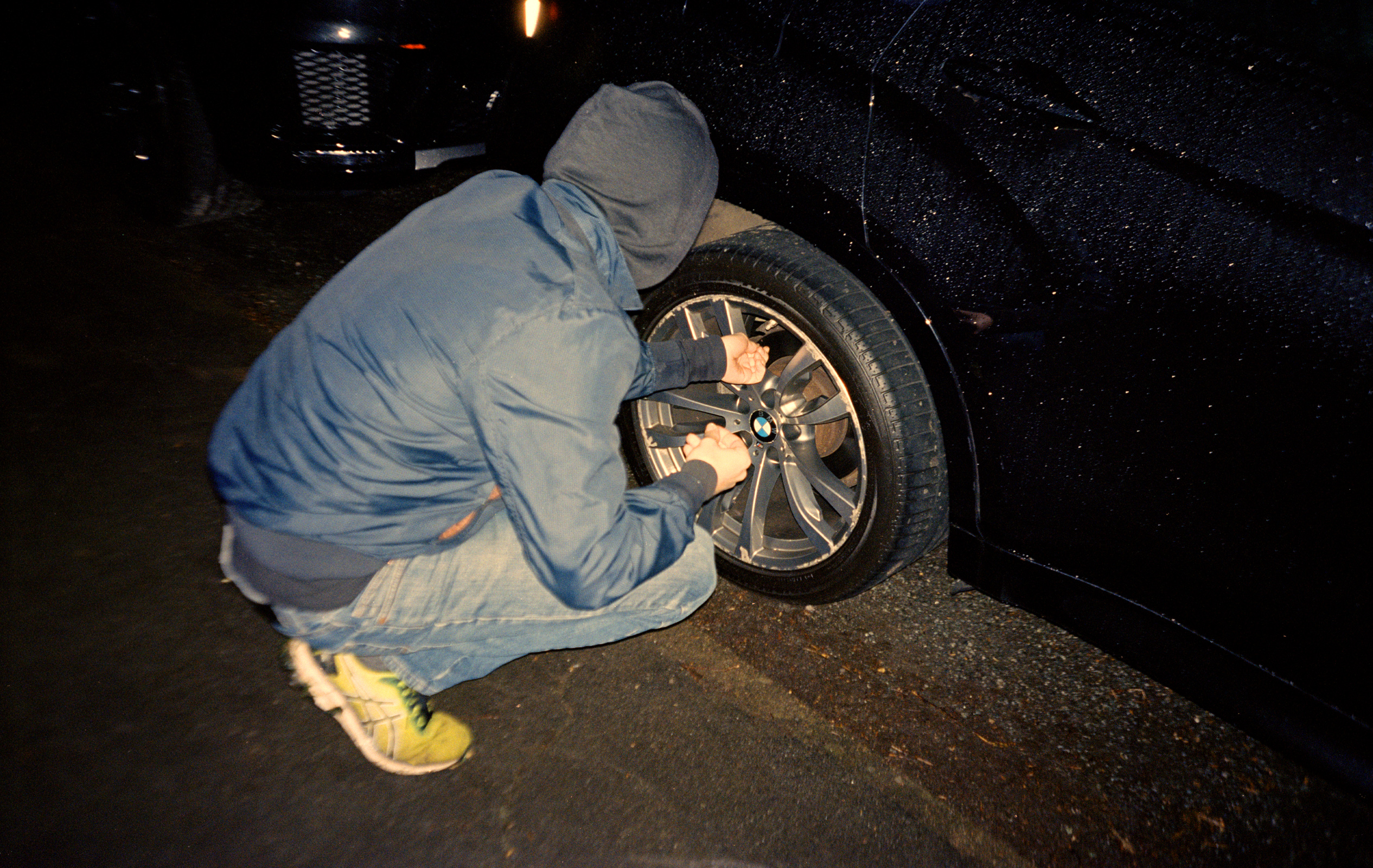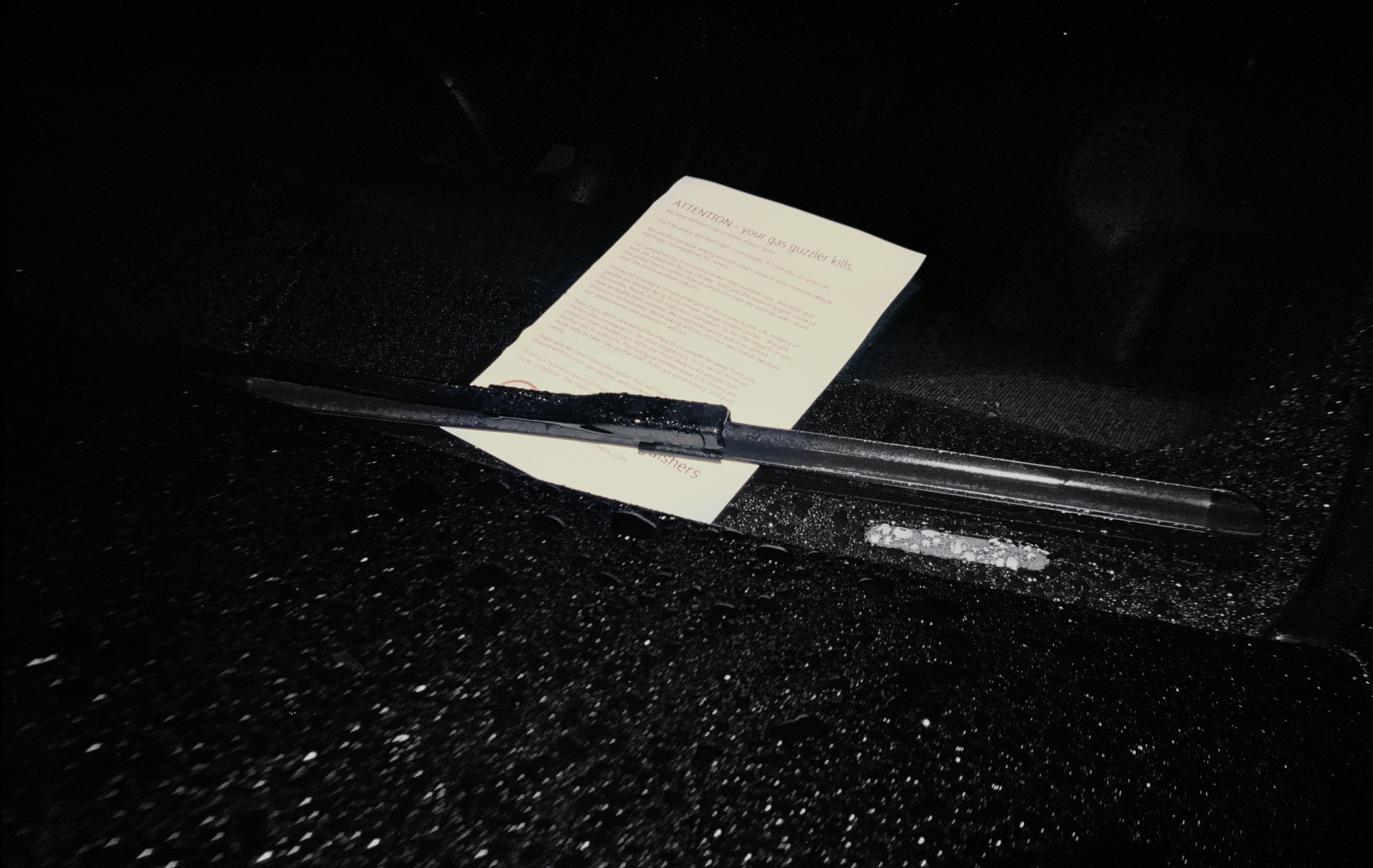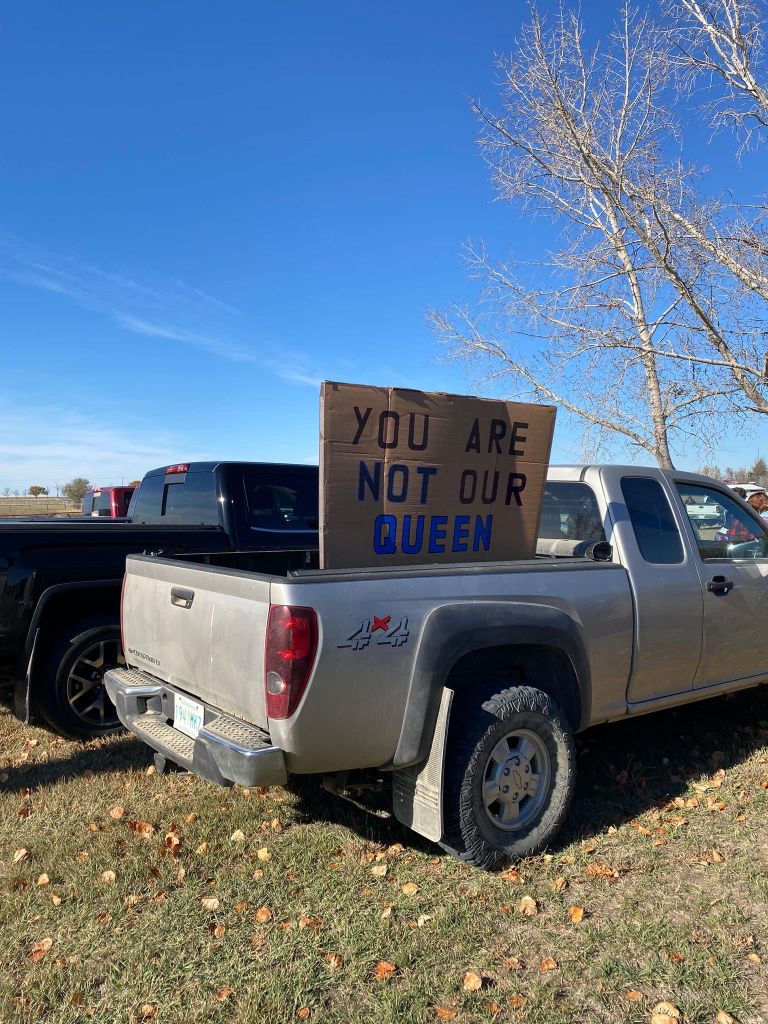Nobody’s actually wearing a balaclava. There is a sense that doing so might make things feel a bit intense. But, as we gather at a discreet rendezvous point on Bristol’s eerie, early-morning streets, you get the feeling that we’re not far off that state of things. There are hushed greetings, but that’s all: we’re all nervous, and we all know the plan.
Our group splits up: the pair I’m with peels off down an encouragingly fancy-looking side-street. It’s been agreed that we should only start running in quite specific circumstances, so we walk briskly, watching and listening intently. The guy in front of me signals, and we indulge a quick exchange of 0.1db glee: our first encounter of the night will be with a Range Rover.
Videos by VICE
One of the team, who we’ve agreed I will call Holly, walks to an armour-plated corner and drops to the wheel. Watching the street behind, I hear some fiddling, a pause, and then that ever-so-distinctive little hiss. It always seems a bit incongruous when coming from a two-ton behemoth. But perhaps this incongruity itself is apt: this tiny crew, alongside an unknown number of others all over the world, is hoping to take on the mighty automotive empire and win.
The Tyre Extinguishers (TE) are something between a movement and a tactic with ideas. The name first appeared in 2021, but it’s only since March 2022 that they’ve actually been out on the streets. Since then they’ve run actions in at least eight cities across the UK, totalling (though not in that way) more than 3,000 SUVs, according to their own numbers. They’ve translated their materials into four different languages, in each case on request, and are reporting actions multiplying globally via their sparse website and saucy Twitter page.
The group’s stated mission is “to make it impossible to own a huge polluting 4×4 in the world’s urban areas”, on the grounds of climate, air pollution, road safety, and their function as status symbols; they say their campaign is just getting started.
The crew I’m with would certainly support this last claim: This is just their second action, having sprung into existence weeks before following a discussion in a pub. They’ve had no contact with anybody else under the Tyre Extinguisher banner – “it really was a case of picking up a leaflet and a lentil and getting stuck in”, one tells me.

Yes, lentil. Such is their unlikely armament. I’m treated to a solemn demonstration of the process: a masked figure removes the valve-cap from a looming Porsche, adds a lentil and returns the cap – tightening until it hisses. The whole thing takes about ten seconds. “They generally go flat within about an hour,” my instructor tells me stonily. Holly, who was on look-out, now takes one of the group’s essential leaflets and leans a little awkwardly to tuck it underneath a windscreen wiper. We move on, business-like.
We continue at a stop-start pace, heads on swivels scanning for the hoped-for hulks of SUVs, or the less warmly anticipated sounds or silhouettes of members of the public or police. Despite everything, I find myself yawning.
There’s certainly a kind of thrill in being up at this ungodly hour, donning your darkest clothes, your most concealing headgear, and converging on what it feels unusually legit to refer to as “the rendezvous point”. There’s no denying the primal adrenaline involved in being both a kind of predator and a potential prey; the sense of reclaimed agency that spans both the immediately tangible and the more abstractly historical (“this sure beats being on a march,” Holly observes during an empty stretch of high-class road).

On the other hand, it’s also kind of boring. The action’s parallels with hunting are, thankfully, quite limited: The SUVs do not need chasing, we don’t bump into anybody and we hear no sirens. The main concern is the surveillance state: We take convoluted measures to reduce the odds of being tracked by CCTV, and keep our masks on tight throughout the proceedings. The greatest drama of the night comes off the back of our triggering a motion-sensing light. This isn’t one of our “run-for-it” scenarios: we strut away nervously, round a corner, and then get back to work.
By the end of the night, as the groups reconvene, the air’s still charged with that strange mix of tired excitement and grim solemnity. The parting hugs seem just as much like consolations as congratulations. The plan is now to scatter, to reduce the odds of being tracked. “Good shift,” somebody says.
I catch up with Holly later, in much more normal clothes and circumstances. Apart from being in her 20s, she’s a long way from the tabloids’ ideal of an “eco-zealot”: she has a serious-sounding career, and chooses her words carefully. I ask her how it feels to be a Tyre Extinguisher.
“As much as it’s exciting to be doing something that we think might be effective, it feels surprisingly like doing a job – just something that you have to do. It isn’t fun: I hate disrupting people’s lives, and it’s upsetting that it’s come to this. But it has come to this.
“We feel that nothing else will work – we don’t have any more time for letters or marches or waiting for more elections. We’ve had those strategies for 30 years and they’re not working. It’s time to shake things up.”

The use of lentils against SUV tyres, however novel it might seem, is not in fact a new idea: it started with a group of Swedes in 2007. This is so long ago that the group published a “weblog” for publicity, and called themselves “The Indians of the Asphalt Jungle”. They saw some serious success, claiming more than 1,500 “disarmed” SUVs, achieving widespread coverage in the Swedish press, and helping to send the usually relentless growth of domestic SUV sales into a rare reverse. But circumstances shifted, attention was diverted towards that year’s much-hyped COP15 in Copenhagen, and the inappropriately-named Indians vanished into the mists of time.
The intervening 15 years have brought a lot more than linguistic shifts. The “climate change” referred to by the Swedish group is now a full-blown crisis. The 1.5°C target is dead in the ice-free water, and people are getting really fucking worried. About 4 million people in the UK are interested in taking disruptive action for the climate. Antonio Guterres, the UN Secretary General, is practically inciting such measures.
This changing mood is getting harder to mistake. Take Andreas Malm’s book How to Blow up a Pipeline. In 2007, this explicit call for those who care about the planet to use violence (against property) would probably have been dismissed as lunacy; in 2021, it was met with disarmingly rosy reviews in top-flight papers.
Neatly enough, the author was in fact one of those Swedish pioneers in lentil sabotage, and How to Blow frankly describes and recommends this tactic. Tyre Extinguishers HQ (who’ll only talk to me by email on security grounds) say they were inspired by the book: “Anyone serious about the climate crisis should read [it]. There comes a point where asking politely and protesting has stopped working… it’s time for action, to sabotage the machines that are killing us”.

Holly is a case in point of someone who’s been moved to action by the growing sense of crisis. “I was just a normal person, getting on with my life, trying to do the right thing where I could. But then it suddenly just clicked. The UN says we’re ‘firmly on track for an unlivable world’; our leaders are making it worse, they’re still expanding our emissions because that’s where the money is. And it’s not future generations that will pay the price, not any more – it’s us, it’s happening now. Millions are already dying from extreme weather, crop failure, war, and this is just the start.
“Now it’s the only thing I ever think about: it shapes every decision I make. I’ll do whatever works, and if that means upsetting people, then that’s where we are.”
The “vibe shift” since that first campaign in Sweden isn’t just a macro climate thing. Down on the ground, cars in general (and SUVs in particular) have been taking on new cultural and literal dimensions.
Simply put, the car market’s gone nuts for SUVs. Their share of global car sales has soared from 16.5 percent in 2010 to 45 percent today. This has huge implications for our biosphere: The SUV boom is the second largest contributor to rising emissions, and according to a 2020 Guardian feature, if these vehicles’ drivers were a nation, they’d be the seventh biggest CO2 emitter in the world.
None of which seems to bother the industry. One model of Land Rover is sold under the slogan “Life is so much better without restrictions” – maddeningly fitting for a car accused of emitting 250 percent of the EU carbon target. One wonders if they take the same approach to speed restrictions; this too would be appropriate, since SUVs are also massively more dangerous – twice as likely to kill pedestrians on impact, and influencing drivers into habits which increase the odds of such collisions.
But Sports Utility Vehicles, as the bizarre name implies, were always so much more than their physical forms. More than almost any other class of car they mean something – and, as GQ mag boasts, that meaning has become “fuck you”. The vehicles are joyously vaunted as “gas-guzzling, attention-getting, Bernie Sanders-enraging totems of wealth” which “might incur the wrath of the plebes”.

In times of inequality to rival the 1920s, with 2 million UK adults skipping meals on economic grounds, SUVs are rolling reminders that others can drop £50,000 – or for a new Range Rover, twice that – on a status symbol.
Holly steers clear of class warfare though: “They’re dangerous, they are extravagant, they are a huge waste of resources… but it’s not about hating the people who drive them or use them. If we have an enemy, it’s all the marketing and greenwashing and lobbying that misleads people and traps them in a world designed for cars.”
Indeed even their owners will, often as not, gesture helplessly at the “arms race” in which they want to keep their loved ones and themselves safely on top. (It’s one of life’s many sour ironies, as comprehensively explained by none other than Malcom Gladwell, that these behemoths can leave even their occupants at greater risk.)
All of which leaves us, very much like with the wider climate crisis, in a surreal predicament where anyone sane would agree it’s a problem – but where the answer seems to be to wring our hands and watch as it gets annually worse. So have TE found the answer?
Most of the internet would seem to disagree with the Extinguishers’ approach. Vehemently. The main riposte is that the strategy in use is counterproductive: that people calling out roadside assistance to restore the missing air will mean more emissions, not less; and that affected SUV owners will feel alienated, and end up less likely to favour climate policy.

Others dwell on the risk that if the leaflet on the windscreen were somehow removed, and if the owner were to set off without noticing one (or several) tyres being flat, there could be accidents.
Most of the online talk of death or injury, though, concerns the Extinguishers. TE Central have said they use hatemail to track their growth: it’s more dependable than news reports or even updates from their operating groups. They send me some examples, with a content warning for graphic violence.
“Slit your wrists and bathe in your own blood you stupid cunts”; “Biggest scum of humanity, right after pedophiles”; “You are all scum in my opinion and no different to ISIS/SIL using terror to achieve your stupid agenda”; “Touch my vehicle, and your ‘activist’ will not walk away. They will be wheeled away. On a stretcher. Fuck you guys, and fuck the environment. Vroom vroom cunts. Hopefully you mess with the wrong person’s vehicle and get fucking shot. You deserve to be tortured to death and your graves pissed on.”
The group claim not to care about these superheated words. “We find it amusing,” they tell me; “[It] just goes to show how some people (mostly men)’s sense of worth and identity is so closely linked to their cars. The death threats don’t deter us at all.”
On some level their blasé attitude can be seen as the flinty new mood of the wider climate movement; but unlike almost any other strand of that movement, TE enjoys a strategy which offers full expression to that mood. For all the fearlessness of those involved in Insulate Britain and Just Stop Oil, these groups are still reliant on media breakthroughs and some level of public support or interest to reach their audience.
In theory, TE could achieve its mission without any coverage whatsoever in the billionaire-owned press; as David Graeber put it, “Protest is like begging the powers that be to dig a well. Direct action is digging the well and daring them to stop you”.
Of course, strategic independence from media discourse doesn’t mean indifference to it. Despite the TE website’s designation of electric SUVs as “fair game”, the extinguishers I talk to have concerns about holding the narrative:
“They’re not the answer to our transport problem.” Holly says. “They depend on scarce resources, they still impact on cities in terrible ways, they’re only better if we assume they’re charged using renewables – but we don’t want to let hostile journalists confuse the issue by talking about how EVs [electric vehicles] are fine when over 98 percent of SUVs still use combustion.”
Similarly, TE Central note with obvious pleasure that “the public has been more supportive than we would have thought”. Just like with the hatemail they offer several examples, including one of numerous “requests”: “Plenty of SUVs and Land Rovers down [redacted street in North London]. Number 35 has several gas guzzlers. Go for it!”. No doubt their favourite exhibit, though, is a piece in The Telegraph, essentially advising readers to jump out of SUVs before their valves are pushed.
The Telegraph’s pragmatic climbdown seems an early glimpse of one potential endgame: where TE’s promise to “make it impossible to own a huge polluting 4×4 in the world’s urban areas” is outpaced by their message, and “Socially Unacceptable Vehicles” become the new cigarettes. TE are keen on the idea of governments enabling the hoped-for change, with “bans on SUVs in urban areas, pollution levies to tax SUVs out of existence, and massive investment in free, comprehensive public transport”.
“But,” they add, “until politicians make this a reality, Tyre Extinguishers’ action will continue.”
Of course, the Indians of the Asphalt Jungle promised something similar. Perhaps part of the reason why they called a “ceasefire” at the end of 2007 was the appearance of a putative militia “threatening to deflate the lungs of the Indians”. This threat was never carried out, but it can’t have been much of a joke to those involved.
Again though, maybe times have changed. I ask Holly if she’s worried about potential consequences for herself, lawful or otherwise. She fires back with barely a pause: “I’m more worried about the consequences if we don’t get a grip on the climate crisis… some risks are worth taking”. My TE Central contact, truculent as ever, speculates on how many gallons of coffee would be needed for an all-hours vigil, concluding “we are very unlikely to be caught”.
Unlike Extinction Rebellion’s controversial “arrest strategy”, TE are not seeking to put their bodies in the way of harm. But as the movement grows, the possibility will loom that someone carrying a lentil could find themselves the victim of a whole new breed of anti-climate vigilante violence (comparatively novel for the west, but a horrific everyday reality across the global south).
Malm himself proposes, without relish, that the global population’s accelerating comprehension and experience of climate breakdown will lead to escalations of tactics and reprisals far beyond what’s happening now. Out-and-out violence and sabotage. It seems worth noting that, often as not, the upstanding friends and family I tell about TE assume that the tyres are being slashed, not lentilled; this misapprehension seems ominously telling.
For now, in any case, the movement/tactic/idea is growing fast. TE groups have been popping up all over Western Europe and the US, with more recent arrivals in New Zealand. And with bloodcurdling forecasts of extreme heat this summer, we could conceivably see TE groups around the world channel their real-time dismay at global disasters (more Indian heatwaves, Australian wildfires, devastating typhoons or other horrors) into practical efforts which deal directly with the problem, one tyre at a time. Such emergent campaigns – all but impossible for larger groups with slower methods – could seize the moral narrative in ways that might prove difficult for even the almighty car lobby to fight.
Holly’s group is growing too: They’ve been inspired by the Brighton network’s recent announcement of 250 deflated vehicles in just one night, and want to rally Bristol’s reputation as a progressive pioneer.
My new friend reckons she can keep up with extinguishing indefinitely: “The worst part is working the morning after without much sleep. But it’s worth it, to feel you’re doing something meaningful.
“You get a different perspective on the roads. You find it difficult to stop seeing the SUVs: as dangerous, extravagant, as marketing snake oil – but also as opportunities. You feel empowered – not just a passenger on our collective drive over the cliff.”





